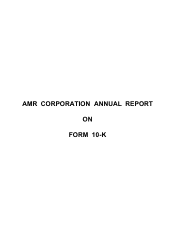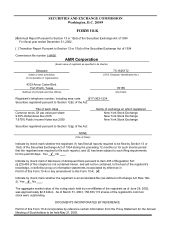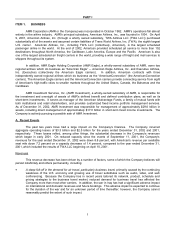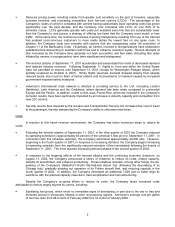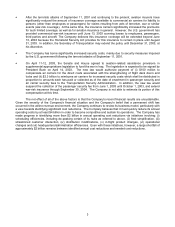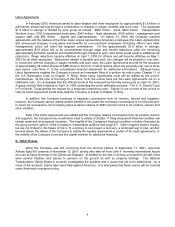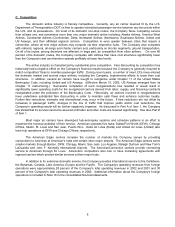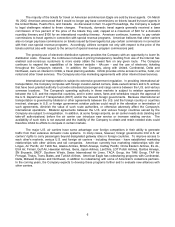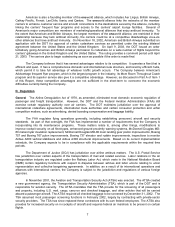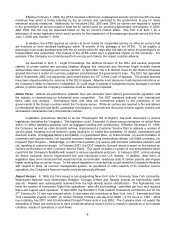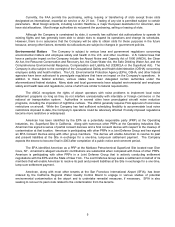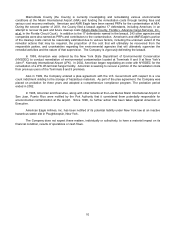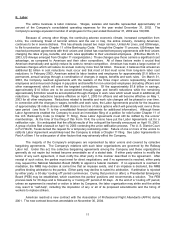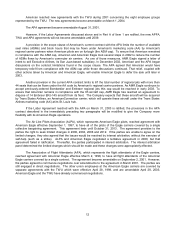American Airlines 2002 Annual Report Download - page 4
Download and view the complete annual report
Please find page 4 of the 2002 American Airlines annual report below. You can navigate through the pages in the report by either clicking on the pages listed below, or by using the keyword search tool below to find specific information within the annual report.
2
• Reduced pricing power, resulting mainly from greater cost sensitivity on the part of travelers, especially
business travelers, and increasing competition from low-cost carriers (LCCs). The percentage of the
Company’s routes on which it competes with carriers having substantially lower operating costs has grown
significantly over the past decade, and the Company now competes with LCCs on over 80% of its
domestic routes. LCCs generally operate with costs per available seat mile that are substantially lower
than the Company’s, and pursue a strategy of offering low fares that the Company must match or lose
traffic. At the same time, the continuous increase in pricing transparency resulting from use of the Internet
has enabled cost-conscious customers to more easily obtain the lowest fare on any given route. In
addition, the Company must now compete with carriers that are reorganizing under the protection of
Chapter 11 of the Bankruptcy Code. Historically, air carriers involved in reorganizations have undertaken
substantial fare discounting to maintain cash flows and to enhance customer loyalty. Recent attempts at
fare increases by the Company have generally not been successful, and fare sales (including fare sales
initiated by carriers in reorganization) have been significant and widespread.
• The terrorist attacks of September 11, 2001 accelerated and exacerbated the trend of decreased demand
and reduced industry revenues. Following September 11, flights to, from and within the United States
were not permitted to resume until September 13, 2001 (except for Washington Reagan Airport, which
partially reopened on October 4, 2001). When flights resumed, demand dropped sharply from already
reduced levels, due in part to fears of further attacks and inconvenience to travelers caused by increased
government-imposed safety measures.
• American's international route network is directed to providing service to the U.K. (including London
Heathrow), Latin America and the Caribbean, where demand has been weak compared to continental
Europe and the Pacific. In addition, routes to San Juan, Puerto Rico, which are included in the Company's
domestic results, have been particularly impacted by an increase in industry capacity and competition from
new LCC service.
• Security service fees imposed by the Aviation and Transportation Security Act increased the cost of travel
to the passenger, thereby dampening the Company’s ability to otherwise raise fares.
Costs
In reaction to this harsh revenue environment, the Company has taken numerous steps to reduce its
costs:
• Following the terrorist attacks of September 11, 2001, in the third quarter of 2001 the Company reduced
its operating schedule to approximately 80 percent of the schedule it flew prior to September 11, 2001. In
connection with this schedule reduction, the Company eliminated approximately 20,000 jobs. However,
beginning in the fourth quarter of 2001, in response to increasing demand, the Company began increasing
its operating schedule from the significantly reduced schedule it flew immediately following the events of
September 11, 2001. The trend towards increasing demand abated in the second quarter of 2002.
• In response to the lingering effects of the terrorist attacks and the continuing economic downturn, on
August 13, 2002, the Company announced a series of initiatives to reduce its costs, reduce capacity,
simplify its aircraft fleet, and enhance productivity. These initiatives included, among other things, the de-
peaking of the Company's Dallas/Fort Worth International Airport hub (following the de-peaking of its
Chicago hub), gradually phasing out operation of its Fokker aircraft fleet, and reducing capacity in the
fourth quarter of 2002. In addition, the Company eliminated an additional 7,000 jobs to better align its
workforce with the planned capacity reductions, fleet simplification and hub restructuring.
Despite the Company's on-going efforts to reduce its costs, the Company faces increased costs
attributable to factors largely beyond its control, including:
• Escalating fuel prices, which show no immediate signs of decreasing, in part due to the war in Iraq and
domestic turmoil in Venezuela, Nigeria or other oil producing regions. American’s average cost per gallon
of fuel has risen from 66.5 cents in February 2002 to 91.0 cents in February 2003.

